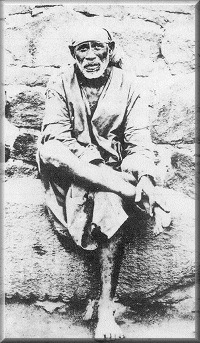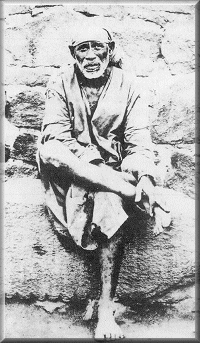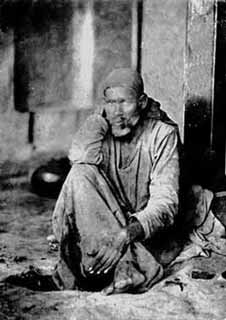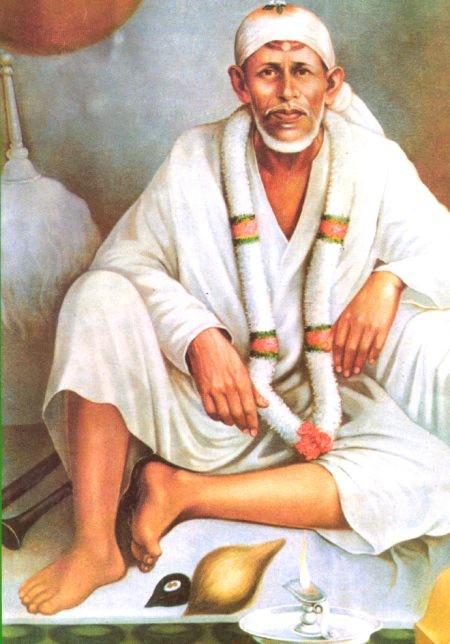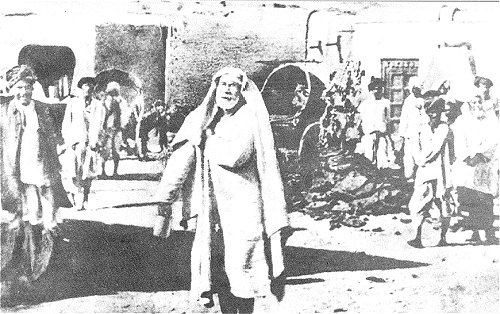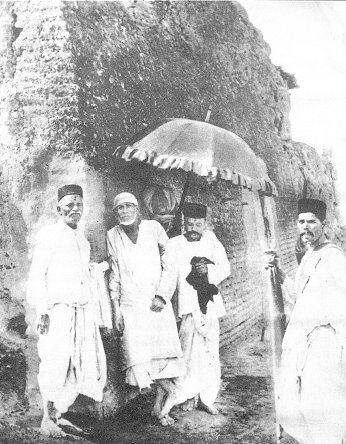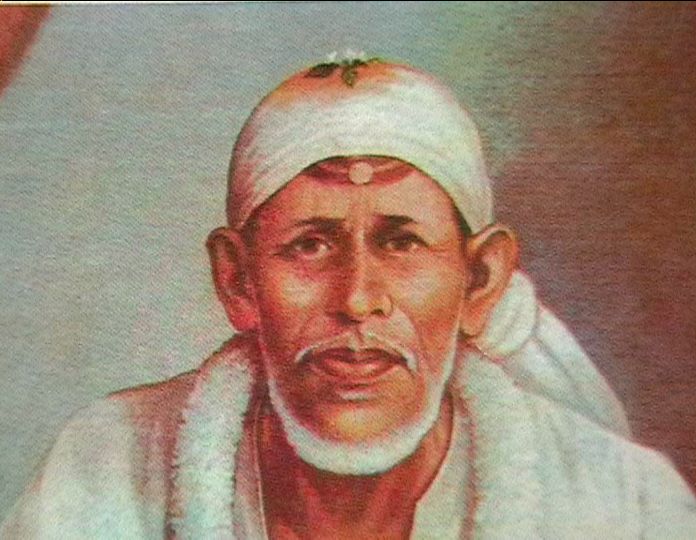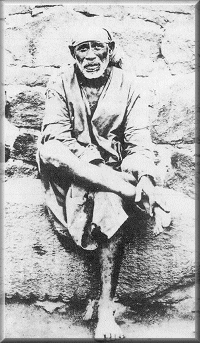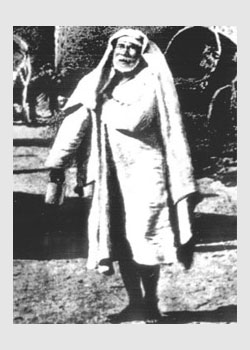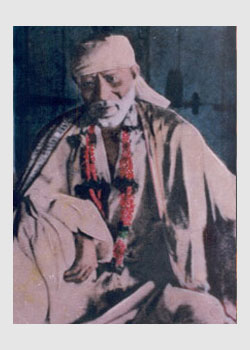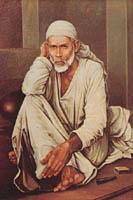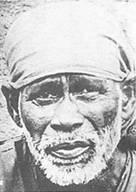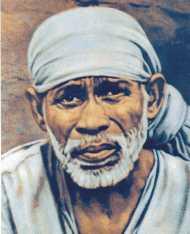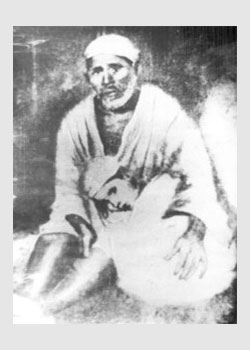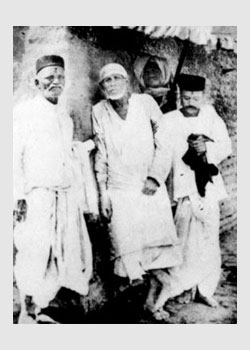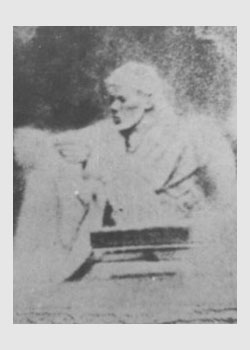He arrived, out of the blue one day, at the small village of Shirdi in the state of Maharashtra, India when he was about sixteen years old. He would not tell anyone anything about himself, but prefered to quietly meditate alone under a tree. Nobody knew the teenager's name or his origins. He lived and died in that tiny village as a beggar monk. He received his name Sai (meaning Saint) from the priest of the local temple who did not know how else to address him but knew that someone extremely special had chosen Shirdi as his permanent home. The name stuck. Later, when he was older, others started adding the name Baba (meaning father in many Asian languages) as a reverential title. His followers were predominantly Hindu and extremely respectful of him.
His followers believe today that Sai Baba has miraculous powers and that he will be ever active and continue to perform miracles from his tomb. The most important holy book of the Sai Baba movement is the Shri Sai Satcharita.
Sai Baba was a mysterious and magnetic personality and never spoke much except with his closest devotees. He used no bed to sleep on (he slept on the hard ground) and used a hard stone brick as a pillow. His ascetism was phenomenal, strictly celibate, he never married or had children. Unlike other saints with his name, he lived a life of extreme discomfort and self-denial. He kept an eternal fire burning in his temple/home and distributed ash from it to his followers. This ash has, even today, has miraculous healing powers when used on sick people. Ash has several symbolic meanings in Hinduism and is placed on people's foreheads as a blessing. He asked for simple offerings (sometimes coins) from people that he, in the very next instant, would give away to other people. He never kept any money or worldly possessions. Followers believe that this unusual behavior was a way to transform them spiritually e.g. by doing away with greed and attachment.
Today, a widely beloved saint in India, his face is seen adorning the millions of shrines, lockets, billboards and even cars of Hindus, Sikhs, Parsees, Christians and Muslims alike. Shirdi Sai Baba has a large following numbering in the millions in Asia, Europe and the United States. While he is recognizable throughout India, his devotees are especially numerous in the state of Maharashtra, the place of his death. The temple where he is buried marks a well-known pilgrimage.
Sai Baba never told his followers that he would be reincarnated or would return in human form and never endorsed any person/s to take over after him when he was alive. He didn’t need to as his presence is felt even now after his demise by millions of faithful devotees.
When asked how he would help devotees in times of need after his death, Sai Baba simply said that his bones in his grave would "speak to them" and aid them if they only thought of him in their hearts. Sai Baba never surrounded himself with riches or finery but chose to live like the rest of most of India, poor, but faithful and proud.
Baba is especially noted for his ability to help his devotees through the medium of dreams.
He arrived, out of the blue one day, at the small village of Shirdi in the state of Maharashtra, India when he was about sixteen years old. He would not tell anyone anything about himself, but prefered to quietly meditate alone under a tree. Nobody knew the teenager's name or his origins. He lived and died in that tiny village as a beggar monk. He received his name Sai (meaning Saint) from the priest of the local temple who did not know how else to address him but knew that someone extremely special had chosen Shirdi as his permanent home. The name stuck. Later, when he was older, others started adding the name Baba (meaning father in many Asian languages) as a reverential title. His followers were predominantly Hindu and extremely respectful of him.
His followers believe today that Sai Baba has miraculous powers and that he will be ever active and continue to perform miracles from his tomb. The most important holy book of the Sai Baba movement is the Shri Sai Satcharita.
Sai Baba was a mysterious and magnetic personality and never spoke much except with his closest devotees. He used no bed to sleep on (he slept on the hard ground) and used a hard stone brick as a pillow. His ascetism was phenomenal, strictly celibate, he never married or had children. Unlike other saints with his name, he lived a life of extreme discomfort and self-denial. He kept an eternal fire burning in his temple/home and distributed ash from it to his followers. This ash has, even today, has miraculous healing powers when used on sick people. Ash has several symbolic meanings in Hinduism and is placed on people's foreheads as a blessing. He asked for simple offerings (sometimes coins) from people that he, in the very next instant, would give away to other people. He never kept any money or worldly possessions. Followers believe that this unusual behavior was a way to transform them spiritually e.g. by doing away with greed and attachment.
Today, a widely beloved saint in India, his face is seen adorning the millions of shrines, lockets, billboards and even cars of Hindus, Sikhs, Parsees, Christians and Muslims alike. Shirdi Sai Baba has a large following numbering in the millions in Asia, Europe and the United States. While he is recognizable throughout India, his devotees are especially numerous in the state of Maharashtra, the place of his death. The temple where he is buried marks a well-known pilgrimage.
Sai Baba never told his followers that he would be reincarnated or would return in human form and never endorsed any person/s to take over after him when he was alive. He didn’t need to as his presence is felt even now after his demise by millions of faithful devotees.
When asked how he would help devotees in times of need after his death, Sai Baba simply said that his bones in his grave would "speak to them" and aid them if they only thought of him in their hearts. Sai Baba never surrounded himself with riches or finery but chose to live like the rest of most of India, poor, but faithful and proud.
Baba is especially noted for his ability to help his devotees through the medium of dreams.
Sponsored by Ancestry
Advertisement
Explore more
Sponsored by Ancestry
Advertisement
